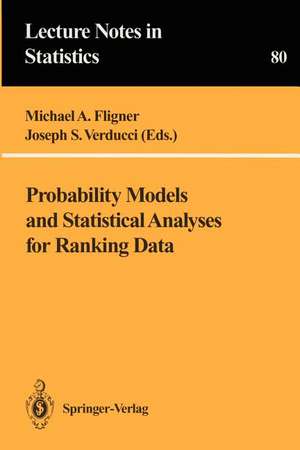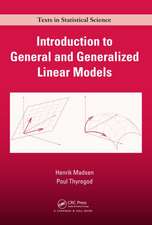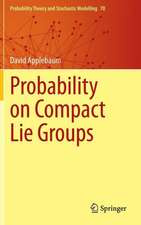Probability Models and Statistical Analyses for Ranking Data: Lecture Notes in Statistics, cartea 80
Editat de Michael A. Fligner, Joseph S. Verduccien Limba Engleză Paperback – 5 noi 1992
Din seria Lecture Notes in Statistics
- 15%
 Preț: 631.86 lei
Preț: 631.86 lei -
 Preț: 385.84 lei
Preț: 385.84 lei - 17%
 Preț: 490.19 lei
Preț: 490.19 lei - 17%
 Preț: 460.28 lei
Preț: 460.28 lei - 18%
 Preț: 945.92 lei
Preț: 945.92 lei - 20%
 Preț: 561.42 lei
Preț: 561.42 lei - 18%
 Preț: 943.25 lei
Preț: 943.25 lei - 18%
 Preț: 943.25 lei
Preț: 943.25 lei - 18%
 Preț: 995.97 lei
Preț: 995.97 lei - 15%
 Preț: 641.38 lei
Preț: 641.38 lei -
 Preț: 436.14 lei
Preț: 436.14 lei - 15%
 Preț: 633.53 lei
Preț: 633.53 lei - 15%
 Preț: 658.88 lei
Preț: 658.88 lei -
 Preț: 383.33 lei
Preț: 383.33 lei - 15%
 Preț: 640.71 lei
Preț: 640.71 lei - 18%
 Preț: 947.18 lei
Preț: 947.18 lei - 18%
 Preț: 1007.35 lei
Preț: 1007.35 lei - 18%
 Preț: 942.63 lei
Preț: 942.63 lei - 15%
 Preț: 639.59 lei
Preț: 639.59 lei - 18%
 Preț: 1231.47 lei
Preț: 1231.47 lei - 15%
 Preț: 643.00 lei
Preț: 643.00 lei - 18%
 Preț: 886.62 lei
Preț: 886.62 lei -
 Preț: 383.12 lei
Preț: 383.12 lei - 15%
 Preț: 633.35 lei
Preț: 633.35 lei - 15%
 Preț: 635.65 lei
Preț: 635.65 lei -
 Preț: 393.74 lei
Preț: 393.74 lei - 15%
 Preț: 632.70 lei
Preț: 632.70 lei - 15%
 Preț: 637.28 lei
Preț: 637.28 lei - 15%
 Preț: 702.87 lei
Preț: 702.87 lei - 15%
 Preț: 642.68 lei
Preț: 642.68 lei - 15%
 Preț: 644.63 lei
Preț: 644.63 lei - 15%
 Preț: 645.14 lei
Preț: 645.14 lei -
 Preț: 382.36 lei
Preț: 382.36 lei - 15%
 Preț: 636.30 lei
Preț: 636.30 lei - 15%
 Preț: 647.92 lei
Preț: 647.92 lei -
 Preț: 380.63 lei
Preț: 380.63 lei - 18%
 Preț: 887.05 lei
Preț: 887.05 lei - 15%
 Preț: 634.32 lei
Preț: 634.32 lei - 15%
 Preț: 648.74 lei
Preț: 648.74 lei -
 Preț: 378.92 lei
Preț: 378.92 lei - 15%
 Preț: 648.56 lei
Preț: 648.56 lei - 15%
 Preț: 647.59 lei
Preț: 647.59 lei - 18%
 Preț: 780.37 lei
Preț: 780.37 lei - 15%
 Preț: 641.20 lei
Preț: 641.20 lei - 18%
 Preț: 1102.69 lei
Preț: 1102.69 lei - 15%
 Preț: 643.16 lei
Preț: 643.16 lei -
 Preț: 384.70 lei
Preț: 384.70 lei
Preț: 642.51 lei
Preț vechi: 755.88 lei
-15% Nou
Puncte Express: 964
Preț estimativ în valută:
122.96€ • 127.02$ • 102.33£
122.96€ • 127.02$ • 102.33£
Carte tipărită la comandă
Livrare economică 26 martie-09 aprilie
Preluare comenzi: 021 569.72.76
Specificații
ISBN-13: 9780387979205
ISBN-10: 0387979204
Pagini: 306
Ilustrații: XXIII, 306 p.
Dimensiuni: 155 x 235 x 18 mm
Greutate: 0.48 kg
Ediția:Softcover reprint of the original 1st ed. 1993
Editura: Springer
Colecția Springer
Seria Lecture Notes in Statistics
Locul publicării:New York, NY, United States
ISBN-10: 0387979204
Pagini: 306
Ilustrații: XXIII, 306 p.
Dimensiuni: 155 x 235 x 18 mm
Greutate: 0.48 kg
Ediția:Softcover reprint of the original 1st ed. 1993
Editura: Springer
Colecția Springer
Seria Lecture Notes in Statistics
Locul publicării:New York, NY, United States
Public țintă
ResearchCuprins
1 Ranking Models with Item Covariates.- 1.1 Introduction.- 1.2 Basic Ranking Models and Their Parameters.- 1.3 Ranking Models with Covariates.- 1.4 Estimation.- 1.5 Example.- 1.6 Discussion.- 1.7 Appendix.- 1.8 References.- 2 Nonparametric Methods of Ranking from Paired Comparisons.- 2.1 Introduction and Literature Review.- 2.2 The Proposed Method of Scoring.- 2.3 Distribution Theory and Tests of Significance for ??ij = pij.- 2.4 Ranking Methods.- 2.5 Numerical Example.- 2.6 References.- 3 On the Babington Smith Class of Models for Rankings.- 3.1 Introduction.- 3.2 Alternative Parametrizations and Related Models.- 3.3 Stochastic Transitivity and Item Preference.- 3.4 Examples and Data Analysis.- 3.5 References.- 4 Latent Structure Models for Ranking Data.- 4.1 Introduction.- 4.2 Latent Class Analyses Based on the Bradley-Terry-Luce Model.- 4.3 Latent Class Analyses Based on a Quasi-independence Model.- 4.4 Models that Allow for Association Between Choices within the Classes.- 4.5 References.- 5 Modelling and Analysing Paired Ranking Data.- 5.1 Introduction.- 5.2 Two Models.- 5.3 Estimation and Hypothesis Testing.- 5.4 Analysis of Simulated Data Sets.- 5.5 Analysis of Rogers Data.- 5.6 References.- 6 Maximum Likelihood Estimation in Mallows’s Model Using Partially Ranked Data.- 6.1 Introduction.- 6.2 Notation.- 6.3 Maximum Likelihood Estimation Using the EM Algorithm.- 6.4 Example.- 6.5 Discussion.- 6.6 References.- 7 Extensions of Mallows’ ? Model.- 7.1 Introduction.- 7.2 The General Model.- 7.3 Ties, Partial Rankings.- 7.4 Example: Word Association.- 7.5 Example: APA Voting.- 7.6 Example: ANOVA.- 7.7 Discussion of Contrasts.- 7.8 Appendix.- 7.9 References.- 8 Rank Correlations and the Analysis of Rank-Based Experimental Designs.- 8.1 Introduction.- 8.2 DistanceBased Measures of Correlation.- 8.3 The Problem of m Rankings.- 8.4 The Two Sample Problem.- 8.5 The Problem of m Rankings for a Balanced Incomplete Block Design.- 8.6 The Problem of m Rankings for Cyclic Designs.- 8.7 Measuring Correlation Between Incomplete Rankings.- 8.8 References.- 9 Applications of Thurstonian Models to Ranking Data.- 9.1 Introduction.- 9.2 The Ranking Model.- 9.3 Modeling ?.- 9.4 Subpopulations.- 9.5 Model Estimation and Tests.- 9.6 Applications.- 9.7 Discussion.- 9.8 References.- 10 Probability Models on Rankings and the Electoral Process.- 10.1 Introduction.- 10.2 Electoral Systems.- 10.3 Models for Permutations.- 10.4 The American Psychological Association Election.- 10.5 Simulation Results.- 10.6 Conclusions and Summary.- 10.7 Acknowledgements.- 10.8 References.- 11 Permutations and Regression Models.- 11.1 Introduction.- 11.2 Models for Random Permutations.- 11.3 Sufficient Statistics and Log-linear Models.- 11.4 Conclusions.- 11.5 References.- 12 Aggregation Theorems and the Combination of Probabilistic Rank Orders.- 12.1 Introduction.- 12.2 Notation and Basic Aggregation Theorems.- 12.3 Specific Multidimensional Ranking and Subset Selection Models and Their Properties.- 12.4 Multidimensional Random Variable Models.- 12.5 Conclusion.- 12.6 References.- 13 A Nonparametric Distance Model for Unidimensional Unfolding.- 13.1 Introduction.- 13.2 Social Choice Theory.- 13.3 Distance Measures for Rankings.- 13.4 Strongly Unimodal Distance Models for Rankings.- 13.5 Generalization of Coombs’ and Goodman’s Conditions.- 13.6 Equal Results for ML or MNI Criterion.- 13.7 Unfolding and Social Choice Theory: Illustrations.- 13.8 Discussion.- 13.9 References.- Miscellanea.- Models on Spheres and Models for Permutations.- Complete Consensus and OrderIndependence: Relating Ranking and Choice.- Ranking From Paired Comparisons by Minimizing Inconsistency.- Graphical Techniques for Ranked Data.- Matched Pairs and Ranked Data.















